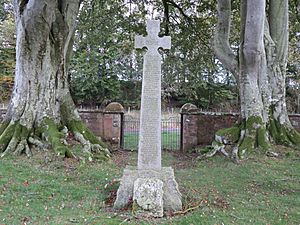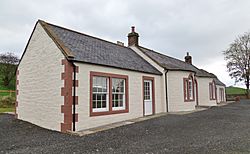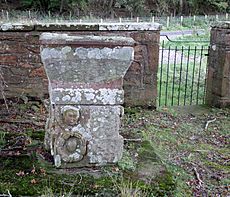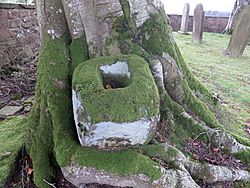Dalgarnock facts for kids
Quick facts for kids Dalgarnock
|
|
|---|---|
 Dalgarnock Churchyard entrance and Martyrs Cross |
|
| OS grid reference | NX878936 |
| Council area | |
| Lieutenancy area | |
| Country | Scotland |
| Sovereign state | United Kingdom |
| Post town | Thornhill |
| Postcode district | DG3 |
| Police | Dumfries and Galloway |
| Fire | Dumfries and Galloway |
| Ambulance | Scottish |
| EU Parliament | Scotland |
| UK Parliament |
|
| Scottish Parliament |
|
Dalgarnock was once a busy village and ancient parish in Scotland. It was located in the Nithsdale area of Dumfries and Galloway, south of Sanquhar and north of Dumfries. The village was a "burgh of regality," meaning it had special rights from the king. It was known for its popular market fairs, which were held from medieval times until 1601.
The Earl of Queensberry moved these markets to Thornhill. This event was even mentioned in a song by the famous poet Robert Burns. After the markets moved, Dalgarnock slowly disappeared. Today, only a quiet churchyard remains where the busy village once stood.
Contents
Discovering Dalgarnock's Past
By the 1790s, no houses were left in Dalgarnock. But people in the 1950s still knew where the village had been. You could even see some signs of it east of the churchyard.
A path used to cross the River Nith from Dalgarnock towards Keir Mill. This path was no longer used by 1899. The nearby town of Thornhill was first called 'New Dalgarnock'. It was built in 1717 on the Earl of Queensberry's land. Thornhill was on the main road connecting Dumfries to Glasgow.
The Old Church and Churchyard
The Dalgarnock church was about a mile south of Thornhill. It was named after St Michael. The church was given to Holyrood Abbey by Edgar, a local chief, around the time of King David I (who died in 1153). The monks of Holyrood Abbey owned the church until the Reformation.
In 1296, a person named Andrew was the vicar (a type of priest) of Dalgarnock. He had to ask the Sheriff of Dumfries to return the church to him. The church's ownership was confirmed by bishops and even the Pope. After the Reformation, the church's income helped support Edinburgh Castle.
The Dalgarnock church was joined with Closeburn parish in 1606. It stopped being used in the 18th century. All church services moved to Closeburn. The old church building has completely disappeared. Its stones were used to build walls and nearby houses. Only the church font (a basin for holy water) survived. It was kept in Closeburn Church and later returned to Dalgarnock churchyard.
The churchyard is a special historical site. It has many gravestones from the 1600s and 1700s. There is also a memorial for the Covenanter martyrs from the Nithsdale area. One old grave is from 1694 and shows the village name as Dalgarnock. Burials were still happening here in the 1850s.
A very unusual grave belongs to John Nivison, a surgeon who died in 1732. His gravestone has a carving of a figure with arms that look like a Green Man. This figure is a symbol of rebirth in some old beliefs.
What Old Maps Show
Old maps help us understand Dalgarnock's history. Timothy Pont's map from 1583-96 clearly shows the 'Kirk of Dalgairnock'. In 1654 and 1732, maps still marked the 'Kirk of Daloairnock'. But by 1747, neither the church nor the village was shown on maps. In 1804, 'Dalgarno' was shown with two buildings, but no church.
St Ninian's Well
There is a small well called St Ninian's Well (or St Michael's Well) near the churchyard. It was filled in 1857 but later reopened. In 1975, it was visible with some stones around it. The well was known for its good, cool water. Today, it is hard to see because it is hidden by plants.
The Covenanters' Story
The Covenanters were a group of Scottish Presbyterians who fought for their religious freedom in the 1600s. Claverhouse, also known as 'Bloody Clavers', was a leader who hunted Covenanters.
A famous story tells of the Covenanter John Porter and Agnes Milligan. Their wedding at Dalgarnock was interrupted by 'Cruel Lag', a known persecutor of Covenanters. John tried to escape across the flooded River Nith using stilts. But he fell into the water. Agnes bravely dived in to save him. People say they were found drowned, holding each other. The spot is still called Porter's Hole.
Many Covenanters from Dalgarnock faced hardship. In May 1684, several local people were declared "Outlaws and Fugitives." These included Alexander Nivison, Robert Dalziel, James Gilkerse, and John Gilkerse.
A tall, white stone cross, called the 'Martyrs Cross', stands in the Dalgarnock churchyard. It was put up in 1925 to remember 57 Nithsdale Covenanters (54 men and 3 women) who died for their faith. A small stone from Australian supporters is also in front of the cross.
The cross lists the names of many martyrs, including:
|
George Allan, Penpont |
James Harkness was a farmer who led the 'Enterkin Raid' in 1684. He and 40 Covenanters rescued seven prisoners from Claverhouse's soldiers. James was captured but escaped to Ulster. His brother Thomas was hanged in Edinburgh. The Harkness family was known for their strong Covenanter beliefs.
James Harkness's memorial stone tells his story:
|
Here lyes the body of James |
Remembering the Covenanters
In 1925, a special outdoor church service called a "Conventicle" was held at Dalgarnock churchyard. It was to honor the Covenanters. Money was raised to build the Martyrs Cross and fix up the churchyard.
Another Conventicle was held in 1928 to officially reveal and dedicate the Martyrs Cross. Many people attended, including a large choir and a military band. Descendants of the martyrs, like the Harkness family, were also there. A further conventicle was held in 2013.
Robert Burns and Dalgarnock
The famous Scottish poet Robert Burns mentioned Dalgarnock in his 1795 song "Last May a Braw Wooer." In the song, a lady talks about a man who moved his attention to her cousin after she played hard to get. Burns lived at Ellisland Farm nearby and saw Dalgarnock as a romantic place by the River Nith.
Here are some lines from the song:
|
"But a' the neist week, as I fretted wi' care, "But owre my left shouther I gae him a blink, |
Understanding the Name Dalgarnock
The name Dalgarnock has several possible meanings. It might come from the Scots Gaelic dail gearr enoc, meaning 'field with the short hill'. Another idea is 'Holm of the cry' from Dail gair, referring to the sound of the River Nith. Some think it comes from Old Norman French De la garnoca, meaning 'a large enclosure for cattle'. This makes sense because of the old cattle fairs held here. Many local places still use parts of the name, like Kirkbog and Over Dalgarnock.
Archaeological Finds in Dalgarnock
Near Rosebank, archaeologists found a circular shape on the ground. This is a "round barrow," an ancient burial mound. It has a central pit and a ditch around it. Possible Roman road quarry pits have also been found nearby.
A stone circle once stood at Templeland, but only one stone remains today. The Ordnance Survey map shows Gallows Hill near the Cample Water. This might have been where the local court met and where punishments took place long ago.
The Buchanites: A Strange Religious Group
In the 1780s, a very unusual religious group called the Buchanites lived near Dalgarnock. Their leader was Elspeth Buchan. They built a home called 'Buchan Ha' at New Cample farm.
Around 1785, all 46 of her followers gathered on a wooden platform they built on Templand Hill. They hoped to fly up to heaven with their leader, Luckie Buchan. They had even shaved their hair, leaving a tuft for angels to pull them up! The platform collapsed, and the Buchanites soon moved to a new home.
The McMilligan of Dalgarnock Ghost Story
At Tynron, there's a landmark called Tynron Doon. People say the ghost of a headless horseman rides a black horse there. The legend tells of a young gentleman from the M'Milligan family of Dalgarnock. He went to visit the daughter of the Laird of Tynron Castle. But one of her brothers didn't like him.
They argued, and the young man rode off in anger. He took the wrong path and galloped over the steepest part of the hill, breaking his neck. Because he died with angry words on his lips, his spirit is said to be trapped and unable to rest.
Images for kids






